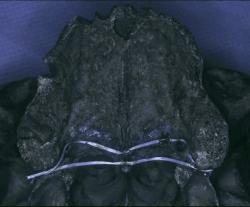COMPLETE DENTURES
17. POSTERIOR PALATAL SEAL
Anterior "Vibrating" Line
This is the familiar "junction of the hard and soft palate." (The "hard" and "soft" palate is a clinical judgment based upon palpation.) It is the place where very little soft tissue (hard palate) meets more soft tissue (soft palate). We want to begin our seal only in an area of more soft tissue. (The entire posterior palatal seal is on soft palate.) I use the end of a mirror handle to feel where the soft tissue begins. Be aware there is bone under that soft tissue.
(The "bony" palate is the anatomic palate and consists of the bones (maxilla, palatine) that make up the palate. It is not a clinical judgment. To put this another way, think of a clinical crown and an anatomic crown. The clinical crown can change because it is a function of the location of the soft tissue. This requires a judgment. The anatomic crown is the same no matter where the soft tissue.)
A portion of the soft palate overlaps the bony palate. This is the area of the posterior palatal seal. (Check diagram in Section 17. Posterior Palatal Seal, "Maintaining Suction of the Maxillary Denture.")
With this unusual skull there is a large depression in the bone shaped like a cupid's bow which was filled with soft tissue. Had you been making a denture for this individual you might have mistakenly made a too wide (anterior-posterior) palatal seal. To correct this you would have had to draw the anterior line closer to the posterior line to keep it within the 7mm width rule. That is why the posterior vibrating line is drawn first, so it will help you locate the limits for the anterior vibrating line. Ideally the anterior vibrating line will be at the "junction."
You will notice the title of this section is anterior "vibrating" line, with the word vibrating in quotes. I have never seen the anterior line vibrate or even quiver. Check it out.

|
17. Do not include the tuberosity (which is not soft palate) in your outline of the posterior palatal seal. Make your anterior vibrating line go around the lingual border of the tuberosity. Adjacent to the lingual border of the tuberosity is the greater palatine foramen. This is an area of soft tissue. Feel around the tuberosity to the greater palatine foramen and then move medially to the midpalatal suture where there is a small ridge of bone (less soft tissue). Here the anterior posterior width of the soft tissue is less. Follow the same pattern on the other side and you have completed the cupid's bow outline. Your greatest anterior posterior width should not be more than 7mm. (Ignore the wax used to hold down the dental tape.)
|
©1999 by Julius Rosen, D.D.S.
